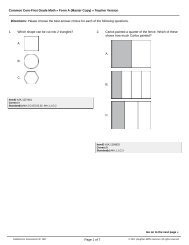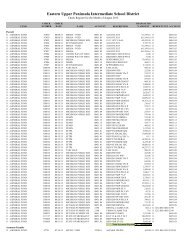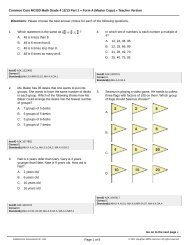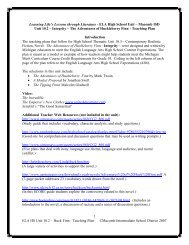Teaching Algebra with Manipulatives
Teaching Algebra with Manipulatives
Teaching Algebra with Manipulatives
Create successful ePaper yourself
Turn your PDF publications into a flip-book with our unique Google optimized e-Paper software.
Chapter 10 <strong>Teaching</strong> Notes and Overview<br />
<strong>Algebra</strong> Activity<br />
A Fascinating Fold<br />
(p. 180 of this booklet)<br />
Use With Lesson 10-5.<br />
Objective Investigate a relationship between<br />
certain exponential functions.<br />
Materials<br />
grid paper<br />
straightedge<br />
Do this activity <strong>with</strong> the whole class. Go over<br />
the general plan of the <strong>Algebra</strong> Activity. Next,<br />
have students complete the table for the three<br />
functions in Step 1. Then ask them to prepare<br />
the grid paper as stated in the directions for<br />
Step 2 and graph y 2 x .<br />
In Step 3, have them fold the grid paper along<br />
the y-axis of the graph y 2 x . Mark the points<br />
from y 2 x onto Quadrant II. Unfold the paper<br />
and connect the points <strong>with</strong> a smooth curve. At<br />
this time, you may want to review how to<br />
evaluate an expression like 1 2 3 , that is, 8.<br />
Point out that the reflection of the point (3, 8)<br />
from y 2 x over the y-axis is (3, 8) from<br />
y <br />
1 2 x . Ask students to complete the table for<br />
y <br />
1 2 x . Before students begin Exercises 1–3,<br />
they should realize that they are finding the<br />
reflections of y 3 x and y 4 x over the y-axis<br />
and writing a paragraph describing any<br />
discoveries they made from doing the activity.<br />
Interested students may want to investigate<br />
negative values for x for y 2 x and other<br />
exponential functions, and share their findings<br />
<strong>with</strong> the rest of the class.<br />
Step 1<br />
x 2 x (x, 2 x ) 3 x (x, 3 x ) 4 x (x, 4 x )<br />
0 1 (0, 1) 1 (0, 1) 1 (0, 1)<br />
1 2 (1, 2) 3 (1, 3) 4 (1, 4)<br />
2 4 (2, 4) 9 (2, 9) 16 (2, 16)<br />
3 8 (3, 8) 27 (3, 27) 64 (3, 64)<br />
4 16 (4, 16) 81 (4, 81) 256 (4, 256)<br />
5 32 (5, 32) 243 (5, 243)<br />
6 64 (6, 64)<br />
Step 2<br />
100 y<br />
90<br />
80<br />
70<br />
60<br />
50<br />
40<br />
30<br />
20<br />
10<br />
O<br />
Step 3<br />
y 2 x<br />
1 2 3 4 5 6 7 8 9 10<br />
x<br />
1 2 x x, 1 2 x <br />
0 1 (0, 1)<br />
1 2 (1, 2)<br />
2 4 (2, 4)<br />
3 8 (3, 8)<br />
4 16 (4, 16)<br />
5 32 (5, 32)<br />
6 64 (6, 64)<br />
x<br />
Answers<br />
1. y 1 3 x 2. y 1 4 x<br />
3. Sample answer: All of the functions in this<br />
activity have a common point, (0, 1). When<br />
you compare a function and its reflection<br />
over the y-axis, the constants that are raised<br />
to a power are reciprocals. So the reflection<br />
© Glencoe/McGraw-Hill 174 <strong>Teaching</strong> <strong>Algebra</strong> <strong>with</strong> <strong>Manipulatives</strong>







